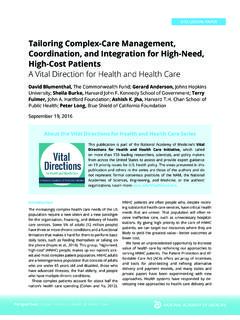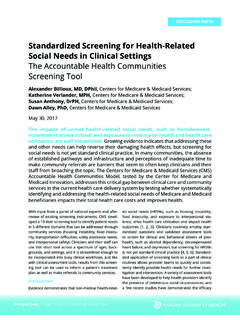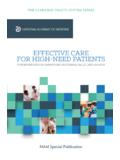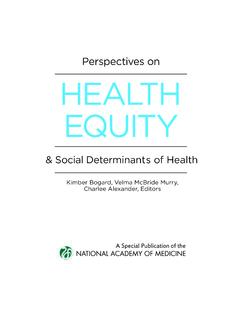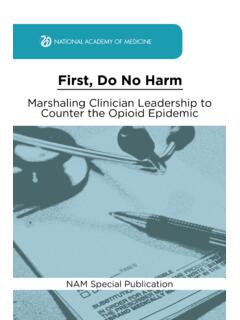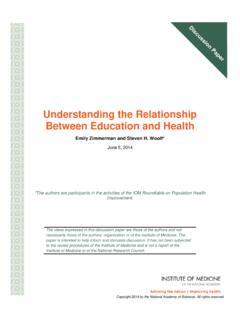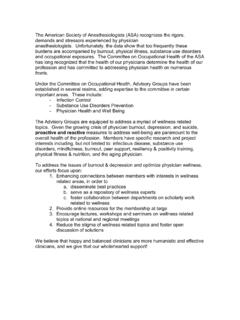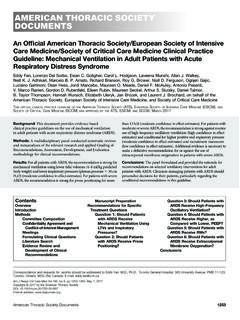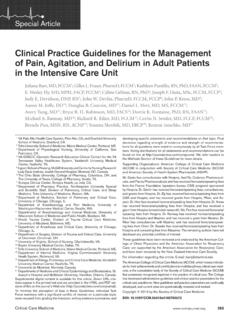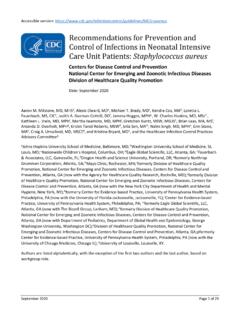Transcription of Innovation and Best Practices in Health Care Scheduling
1 Innovation and Best Practices in Health care Scheduling Lisa Brandenburg, Patricia Gabow, Glenn Steele, John Toussaint, and Bernard J. Tyson* February 2015 *The views expressed in this discussion paper are those of the authors and notnecessarily those of the authors organizations, the Institute of Medicine, or the National Academies. The paper is intended to help inform and stimulate discussion. It has not been subjected to the review procedures of the Institute of Medicine or National Academies and is not a report of the Institute of Medicine, the National Academies, or the National Research Council. Copyright 2015 by the National Academy of Sciences.
2 All rights reserved. AUTHORS Lisa Brandenburg President Seattle Children s Hospital Patricia Gabow Former Chief Executive Officer Denver Health Glenn Steele President and Chief Executive Officer Geisinger Health System John Toussaint Chief Executive Officer ThedaCare Center for Healthcare Value Bernard J. Tyson Chairman and Chief Executive Officer Kaiser Permanente The authors were assisted in their efforts by the following individuals: Kate Burns Institute of Medicine Mark Hallett ThedaCare Center for Healthcare Value Elizabeth Johnston Institute of Medicine Melinda J. Morin Institute of Medicine Murray Ross Kaiser Permanente William Rupp Former Chief Executive Officer Mayo Clinic, Florida 1 Innovation and Best Practices for Health care Scheduling I.
3 Background A. Wait times as a systemic problem B. Cost of waiting C. Scheduling in a complex system D. Dynamic landscape in U. S. Health care II. Wait Time Forces at WorkA. The Scheduling conundrum B. Role of patient acuity and triage C. Considering the Health care setting D. Changing role of the customer-patient E. Managing the Health care workforce F. Need for strategic design G. Scheduling and wait time metrics H. Role of incentives I. Exploring new models of Scheduling III. Our ExperiencesA. Common themes B. Using technology and data to drive change C. Improving internal waits D. Determining capacity: balancing supply and demand E. Redesign of clinic work F. Respect for patients and families G.
4 Identifying benchmarks and setting standards IV. Conclusions and lessons learnedA. Best Practices , best outcomes B. Starting with the basics: supply and demand C. Criteria and approaches to setting standards D. Planning for variability E. Scheduling for a service industry F. Improving access through novel approaches G. A culture of continuous improvement H. Leadership as a precondition 2 Innovation and Best Practices in Health care Scheduling Lisa Brandenburg, Seattle Children s Hospital; Patricia Gabow, formerly Denver Health ; Glenn Steele, Geisinger Health System; John Toussaint, ThedaCare Center for Healthcare Value; Bernard Tyson, Kaiser Permanente1,2 BACKGROUND Patient waits have been a long-standing concern in Health care .
5 Waits occur throughout the continuum of care and are built into and budgeted for within day-to-day operations. The status quo is changing, however, as patient experience becomes linked to provider payment, efficiency and service become differentiators between hospitals and providers, and patient expectations evolve. While excellent clinical care remains the expectation, Health care consumers are now seeking Health care and supporting systems that are respectful of individuals. In this discussion paper, we describe the important forces shaping wait times throughout Health care , the evolving use of techniques and tools from other industries to improve Health care access, and the move toward a person-centered model of care .
6 Through our personal experiences leading our respective Health care organizations, we have tackled these complex issues, and we present in this paper the lessons we have learned along the way. Notably, we acknowledge that improving access and Scheduling requires systems-level transformation and that such transformation can uncover previously unrecognized resources and improve all aspects of care delivery. Wait Times as a Systemic Problem Recent reports of the challenges and consequences faced by patients receiving care in certain Veterans Health Administration (VHA) facilities have drawn attention to the occurrence of prolonged wait times in Health care systems.
7 In a broader context, it is clear that the problem is not exclusive to these VA(VHA) facilities. Similar problems exist throughout Health care ; prolonged wait times, Scheduling difficulties, and an imbalance of supply and demand are issues in both the public and private Health care sectors. Recent VA(VHA) data report that the average wait time for new primary care appointments at VA(VHA) facilities was 42 days (VA, 2014). Although data from the private sector are scarce, a 2013 study of the Massachusetts private sector reported wait times of 50 and 39 days for internal medicine and family Practices respectively (MMS, 2013). Similar observations could be made elsewhere, underscoring the fact that while the recent VA(VHA) 1 The authors are participants in the activities of the Roundtable on Value & Science-Driven Health care .
8 2 Suggested citation: Brandenburg, L., P. Gabow, G. Steele, J. Toussaint, and B. Tyson. 2015. Innovation and best Practices in Health care Scheduling . Discussion paper. Washington, DC: Institute of Medicine. Practices garnered national attention, such problems are similar to, no worse than, and in some instances may be better than those sometimes experienced by nonveteran patients and their families. This problem of Scheduling and access is further complicated by the lack of clear, evidence-based standards for appropriate wait times for both routine primary and specialty care . Although third next available (TNA) appointment and office visit cycle time are validated measures,3 further spread of their use is needed.
9 Best Practices from localized markets currentlyexist as the only comparisons available. What is clear is that the timing and setting of care should be considered in the context of patient condition and Health status. Cost of Waiting The impact of long patient wait times on Health outcomes is not well studied, and the sparse study of the issue precludes making any broad conclusions, except for those individuals with acute conditions, where difficulties with access and lengthy wait times are associated with negative outcomes. Prolonged wait times represent a burden on patients and their families, as reflected by diminished quality of medical care and the adverse experience of obtaining and receiving care .
10 Although not reflecting Health outcomes directly, patients with nonurgent needs who experience prolonged wait times have been shown to have a higher rate of noncompliance and appointment no-shows (Kehle et al., 2011; Pizer and Prentice, 2011). Prolonged wait times and access deficiencies also have a negative impact on providers and staff. Although often unacknowledged, the inefficiencies that exist throughout Health care have been found to contribute to the high level of provider dissatisfaction and burn out in primary care (Sinsky et al., 2013). Using fewer and longer in-person visits and designated patient outreach, Group Health teams were able to integrate e-mail messages, telephone visits, and proactive care activities into their everyday work flow with a significant decrease in provider burnout (Reid et al.)
